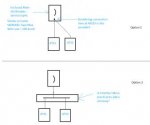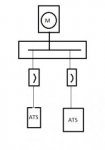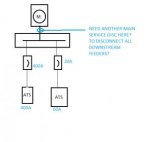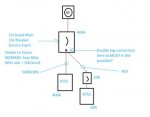Designer69
Senior Member
I have the following question where I need to tap 2 ways from the service main ckt breaker as shown in the pic below.
My question is.. is it better to add the wireway or is it just fine to tap right from the CB using a double lug connector (is this even doable?)
There are only the 2 feeders going to the ATS's so I don't know if the wireway is overkill for this.
Thank You
better pic here: https://ibb.co/b2Q8u8

My question is.. is it better to add the wireway or is it just fine to tap right from the CB using a double lug connector (is this even doable?)
There are only the 2 feeders going to the ATS's so I don't know if the wireway is overkill for this.
Thank You
better pic here: https://ibb.co/b2Q8u8





